Another installment of CFD apparatus images:
More on the CFD apparatus history, engines companies over the years. Thanks to Squad546 for allowing me to use these pictures. I thought it would be nice to put the Ford/E-Ones together.
Former Engine 5 – 1982 Ford/E-One, returning from a run in 1995.Former Engine 8 – 1982 Ford/E-One, headed out on a run in 1995.Former Engine 13 – 1982 Ford/E-One.Former Engine 61 – 1982 Ford/E-One. At one time was one of the busiest engine companies in the country. They recently closed it & now it serves as an EMS Field Division office.Former Engine 78 – 1976 Ford/Pierce after a refurb.Former Engine 113 – 1982 Ford/E-One.Former Engine 127 (Midway Airport) – 1982 Ford/E-One (Never seen a deck gun like this one -Martin)Former E13 – 1982 Ford/E-One running as a spare for Engine 42, taken 1996.
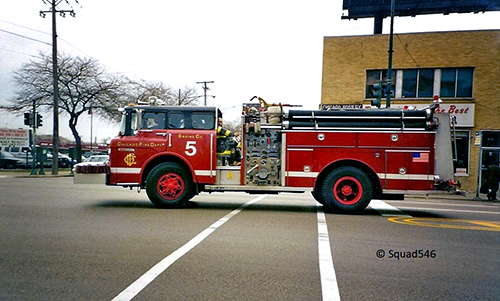
Former Engine 5 – 1982 Ford/E-One, returning from a run in 1995. Photo by Squad546
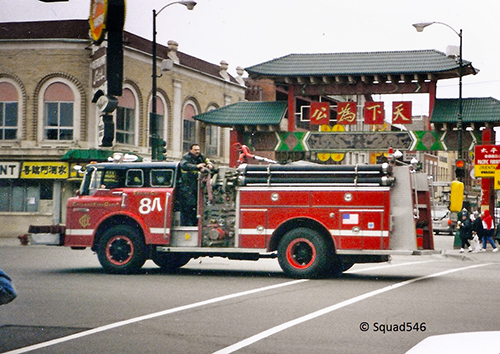
Former Engine 8 – 1982 Ford/E-One, headed out on a run in 1995. photo by Squad546
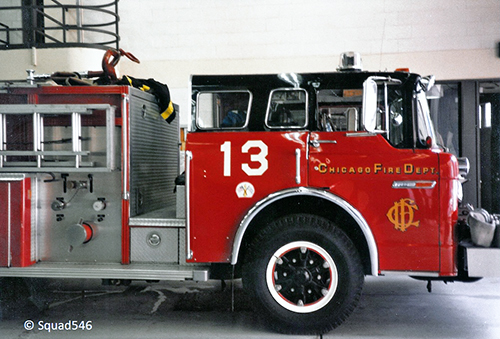
Former Engine 13 – 1982 Ford/E-One. Photo by Squad546
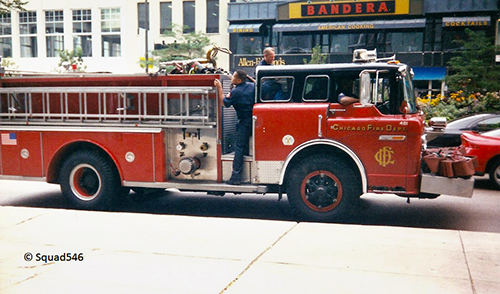
Former E13 – 1982 Ford/E-One running as a spare for Engine 42, taken 1996. Photo by Squad546
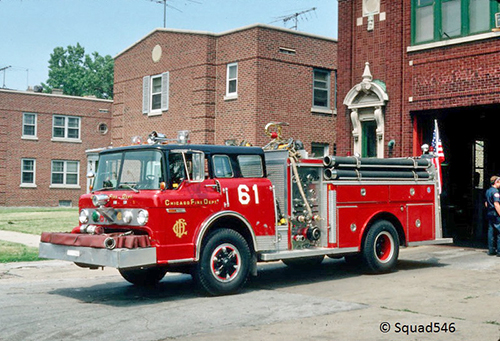
Former Engine 61 – 1982 Ford/E-One. At one time was one of the busiest engine companies in the country. They recently closed it & now it serves as an EMS Field Division office. Photo by Squad546
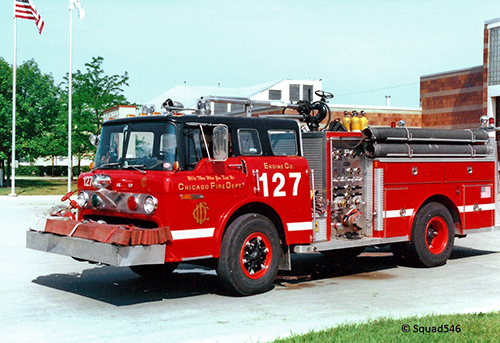
Former Engine 127 (Midway Airport) – 1982 Ford/E-One.Photo by Squad546
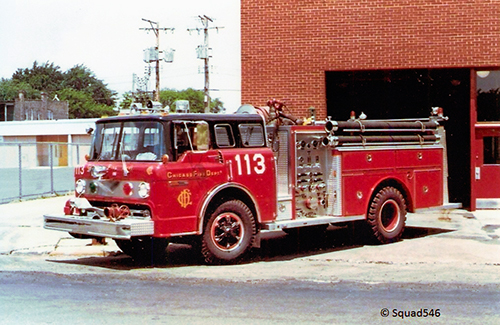
Former Engine 113 – 1982 Ford/E-One. Photo by Squad546

Former Engine 78 – 1976 Ford/Pierce after a refurb. Photo by Squad546






























#1 by DMc77 on December 27, 2014 - 1:41 PM
Chris – the series of books “History of Chicago Firehouses” by Ken Little and John McNalis are your best bet. There is a detailed history of T51’s house on Green St. and other historical information as well as pictures. Your best bet is to also contact the Fire Museum of Greater Chicago, and they can take it from there. They may even have company journals from the time period your uncle served, which will feature his name as well as his handwriting when he stood watch.
#2 by Fred M on December 26, 2014 - 10:04 PM
Danny….I got mine from Bill F. directly. At that time he said they might work on another book on squads. Guess it never came about. Sorry ’bout the 80 bucks…..never knew it would command such a price! Maybe I should sell mine!!!
#3 by Chris Heramb on December 26, 2014 - 8:06 PM
I’m looking for any information on the firehouse at 62nd and Green where my Uncle Jack Toner served on Truck 51. I’m doing a something for my cousin and her new family, so we can learn as much that we can about him and the gentlemen that he served with. If anyone has any information and pictures I would really like to learn as much that I can, so this part of my uncle’s, his daughter’s, and grandchild that he was never able to me could learn about a great man that walk this earth as a true hero. He’s is always missed and never forgotten in memories that we as a family were able to share with him up to when he past. Please anyone who has any information I would love to hear about and also pictures
#4 by danny on December 26, 2014 - 6:47 PM
Fred its out of print i had to pay 80 dollars for one on ebay.
#5 by Fred M on December 26, 2014 - 3:03 PM
If your looking for a great backround on Engines & Trucks in Chicago, check out Bill Friedrich’s and Mark Mitchell’s book titled
“Chicago Fire Dept Engines and Hook & Ladders, 1966-1995”. This lists, with great pic’s, details of Engines Companies apparatus and Ladder Companies…including the number of types purchased by CFD.(Blitz Brothers Publications) WIsh they did one on Squad Co’s, incl Flying Squad Mack rigs and the Snorkel Squads.
#6 by Eric Haak on December 25, 2014 - 6:27 PM
Send a request to the Fire Museum and they will give you all the information they have on him. They are pretty good about helping out with those kind of things.
#7 by Bob on December 25, 2014 - 9:38 AM
I was recently given an old leather helmet that was worn by a man with the last name of ” Wise” starting at CFD in 1920. He rose to the rank of Captain. I found a Frederick C. Wise out of Company 70. Can anyone tell me where to look for more information about him? I would love to know more of the history of this helmet.
#8 by tom sullivan on March 24, 2013 - 10:58 AM
time and heavy use really caught up with the cfd fleet, particulary engines. the early 50s’ macks’ and fwds’ were probably the toughest and simplest to operate (and repair) rigs ever made. there were no booster tanks so weight was kept down (relative to newer rigs). the tens of thousands of runs put on most (all) rigs over a 20+ years along with things like heavy salt baths every winter really destroyed them. we had many rigs with the fenders litterly falling off. fittings were carried in milk crates on the top deck because the (few) compartments were rusted through. one company which had no fenders on it’s rig changed quarters to e-98, when it was seen by the bosses downtown, it was ordered back to it’s own quarters! the guys on the back step would be deluged with road spray in the rain.
after the big snow and the riots it was obvious that replacements had to be accquired as quickly as possible and for the least cost. so we wound up with a fleet of demo’s, repo’s, cancelled orders, (flood soaked), one of a kind, etc. a lot of rigs came with accessory equipment; flood lights, heavy duty winches (on the ward lafrance trucks), etc. stuff that was not needed, or used, a lot of it was eventualy removed and tossed into the yard at the shops.
h&l trucks were in the same situation, wooden aerials were still running into the 70s’, some that couldn’t be raised.
many companies got to the point where they never had an “assigned” rig. they would run with a spare until it broke, then get another spare, and another. there were ’53 mack & fwds still running up to 1976, 23 years, a good return on the investment!
the plan was to start a regular replacement schedule, 10 new engines a year, eventually getting to a 10-15 year service life for engines, after the 2000 gpm ward lafrances, the 1974 mack/howe mb rigs were the start. it was amazing to see the medalian on the steering wheel horn button that said “custom built for the chicago fire department”! those were followed by the first of the E-one fords in 1975. also quite a few american lafrance engines came in about that time, along with alf trucks.
maintenance was still an issue, those macks came with michelin radial tires, when the first tire went flat, the shops had to replace all the tires with bias ply tires from the shop supply, couldn’t mix radial and bias ply. after that the rigs became dangerous to drive in the rain/snow. the rear end would slide out very easily while turning and braking, had to slow way down to keep it straight!
#9 by David on March 24, 2013 - 6:39 AM
As to the variety of rigs the CFD used to run during the last 50 yrs or so, when looking into the 1st edition of the “Wheels Of The Bravest” it seems that the CFD had probably even more front line apparatus types than the FDNY, which I always thought was a No.1 in this business. Quite interesting when you compare the sizes of the dept’s. Boston was another department to have quite a crazy amount of different types considering it’s size but I’d say that the CFD’s definitely a winner in this field. I think that one of the reasons could be also the late 1960s-early 80s NYC budget crisis which pretty much prevented them from purchasing any stuff to beat Chicago. Still this all is just an apparatus buff’s point of view, as Mike Mc pointed out such a diverse fleet must have been a real challenge for the shops.
#10 by RY on March 22, 2013 - 8:22 PM
There is a photo taken at CFD shops in 1978 of E51. Unfortunately it was not the subject of the photo as in deep bg and only partially seen. But it appears to be a Ford C series cabover similar to the photos depicted above. Any info in it?
#11 by Mike Mc on March 22, 2013 - 8:00 PM
Does anyone know why Ford stopped making the C-Series tilt cab? I would have thought that fire apparatus alone would have provided sufficient business to keep it going. It was the fire department’s version of the Crown Victoria. Was it not compatible with an extended crew cab? Thanks in advance for any responses.
Tom Sullivan: I just wanted to second your comment about the wide diversity of engines (and also trucks) on the CFD in the late 1960’s until about the late 1970’s. No other major city came even close in the variety of rigs. It was possible then to go to an extra alarm fire and not see any two rigs that were identical. It was fun for fire fans, but as you noted, it probably drove the engineers and the shops nuts.
Bill Post: I believe the large number of different rigs was for two major reasons – 1. They did not purchase any engines from 1957 through 1964. 2. The great snow of 1967 caused so much wear and tear on the rigs that they began breaking down in unprecedented numbers. Would love to hear your feelings on this.
#12 by RY on March 22, 2013 - 8:30 AM
The pump rating issue, can pump greater than stated on plate, was common practice with several manufacturers and not necessiarly ordered that way. Our 1250 ordered pump could pump 1500 at its annual pump pit test and similar with other apparatus of various pump specs. Some of it is by the actual pump design as a 1250 pump pumps 1500. You order a 1750 it will pump 2000 and so on.
#13 by Chuck on March 21, 2013 - 7:56 PM
The City used to order rigs and have their pump ratings “phonied up”, so to speak…they would order a 1250 GPM pumper, but the pump rating plate would read 1000 GPM, so that when the pump was tested after 10 years (which was I believe the recertification standard back then,) the rig would pass its annual test.
#14 by tom sullivan on March 21, 2013 - 7:56 AM
in the 60s and 70s, it was a challenge for relief engrs (and ffs) who went from engine to engine company on a daily basis to keep up with all the pump panel configurations. in use at the same were 1950s era macks &fwds, later 60s, 70s, 80s ford/ward lafrance, seagrave, e-0nes. custom seagraves & fwds, mack mbs, american lafrances, and don’t forget the airport crash rigs. there were only a few pump brands used; hale, waterous, alf, but they had many different panel arrangements and control placement.
at least one time that i know of, an engine did not get water on the fire in a timely manner, because an engineer from the airport was detailed to an in city company and caught a fire 1st thing in the morning. he was unfamiliar with the pump panel and controls placement. a ff had to return to the engine and assist with the pump.
in the mid 80s some design engineers from the pirsch company came to inspect some of the 1975 ford/e-ones. they were the first ones bought from e-one and had aluminum bodies. they wanted to see how the aluminum held up corrosion wise. the problem as usual, was with the dissimilar metal contact points, hinges, locks, accessory mounts, etc. pirsch was considering building aluminum bodies. they didn’t last as a company much longer.
overall the city got good service out of the ford rigs. they took a beating, lasted a long time, and were relatively easy to maintain, and were very manuverable in tight areas.
#15 by Rusty on March 21, 2013 - 7:40 AM
Chuck,
Two of those ALF Engines went to East Chicago, IN with Chicago’s Paint Scheme. All they did was change graphics.
#16 by DMc77 on March 20, 2013 - 11:36 PM
Two of the E23 ALF’s also went to East Chicago, IN
#17 by Bill Post on March 20, 2013 - 11:05 PM
Two of the 10 ALFs that you are talking about ended up in East Chicago Indiana at Engines 1 and 4 and went in service in the black over red colors.
Chuck as far as those Ward La Frances that you are talking about they were probably the 1,500 gpm models from 1974. Five of them were delivered and actually one of them was rated at 1,750 gpm. The 1,750 gpm model was assigned to Engine 74 and then was reassigned to Engine 104 when they were relocated to Engine 1’s house for a while before being moved to their present quarters on Avenue O. The other 4 were assigned to Engine 57,67,23 and 29.
#18 by NYFF on March 20, 2013 - 10:04 PM
@ chuck: those ALF pumpers like E23s wound up in Baltimore County.
http://bcfdphotoman.zenfolio.com/p633415759/h285cc46c#h285cc46c
#19 by Chuck on March 20, 2013 - 9:12 PM
And there were also the 10 American LaFrances which got built (similar to ex-E23, now the spare Squad) because somebody at ALF thought they had the inside scoop and started building rigs before the contract was ever awarded … wonder where those rigs ended up. E23 had an all-ALF house for a while, with Tower Ladder 5 having that ALF/LTI tower…..
#20 by Chuck on March 20, 2013 - 9:08 PM
Bill, the rigs you mention the city as purchasing – a number of them were kind of “leftovers” or “ordered but not delivered” – there were some Ward LaFrances (not sure if they were the 1500 GPM or the 2000 GPM models) which were refused by the original buyer because the plant had been flooded and the apparatus sat underwater for a while. There was also a 1988 Pirsch aerial which went undelivered to it’s original department, and the city bought it and it served the Fire Academy for many years.
#21 by Bill Post on March 20, 2013 - 1:16 AM
To clarify my previous comment comparing New York’s pumper Fleet and Chicago’s , when I mentioned that Chicago only purchased 4 Engines in 1966, 1 in 1967 and 1 in 1971 that were on “custom chassis” I was talking only about Mack custom chassis such as the C-95 and CF 95 models. During that same time period Chicago did purchase several custom chassised Engines built by other manufactures such as Ward La France, FWD, Seagrave, International Harvester and Oshkosh Pierce.
#22 by Bill Post on March 19, 2013 - 10:55 PM
David, on the subject of the Chicago Fire Department using engines with Ford C-Series chassis, the CFD purchased a total of 83 Ford cab equipped engines if you include the 1988 model Ford/E-One unit that was purchased for the Quinn Fire Academy. They were purchased from 1967 until 1988 if you include the one bought for the Academy.
The first two that were purchased in 1967 were Ford/Ward LaFrances rated at 1000 gpm and they had a 500-gallon booster tank. Later that year Chicago purchased 5 larger models that had 750-gallon booster tanks. As you know even though Chicago had quite a few engines using the Ford C-Series cab, Chicago still didn’t use them exclusively and from the late 1960s until about 1979 we usually purchased them in small quantities of 4 or 5 rigs. In 1979 however they purchased 10 Ford/Seagrave engines, in 1980 they purchased 20 Ford/E-Ones and another 10 in 1982, which was about half of the total number of engines on Ford chassis that Chicago purchased.
During the 1980s, Washington DC and Boston had large fleets of mostly Ford/E-One engines however both Washington and Boston only ran with about 33 engine companies per department. Washington DC however ran all of it’s engine companies as two-piece companies at the time. So technically speaking they were running with about 66 pumpers, most of which but not all of them running Fords.
As far as New York City goes, they always ran with over 200 engine companies and they probably got some good pricing by buying large so many in multi-year contracts (which is something that they still do). I’m sure that for Chicago, price was also a factor because when we started ordering new engines in the mid 1960s, Chicago only purchased four in 1966, one in 1967, and one in 1971 on custom chassis. The 10 Mack/Howes that were ordered in 1974 with the MB600 cabs were really Mack’s commercial series chassis, as opposed to the custom CF model that New York ordered in large quantities beginning in the late 60s through the 80s. Chicago’s 1974 Macks were ordered for their short wheelbase. They apparently were good rigs as they were all rebuilt with new bodies in 1988.
Here is an interesting fact; did you know that the Chicago Fire Department had gone for 10 full years without ordering a single regular engine? The last order was for 10 B-95 Model Mack engines in 1956, which were our only engines from that era that were delivered with booster tanks. The next engines that were ordered were in 1966 and ironically they were four C-95 custom Model Mack engines.
#23 by Chuck on March 19, 2013 - 6:54 PM
Actually, Engine 61 was the SECOND company to utilize the deck gun. The first was Engine 35 back in the 70’s. They had the only Mack CF pumper the city ever bought, and the only one with the prepiped deck gun. They found it quite effective in battling back porch fires, doing a forward leadout from the hydrant (which was almost unheard of at the time,) and leading out into the alley. Engine 61’s claim to fame was to be the first company to utilize the 4″ red hose as a quick water source rather than using the soft suction as the primary supply. And the EMS Field Division has abandoned that house for quarters at the new Engine 16, so I believe that house is now vacant and boarded up.
#24 by David on March 19, 2013 - 4:02 PM
@NYFF True with the Macks, still the CFD had quite a fleet of them back in the 70s and in some cases up until the mid 90s, mainly MBs (engines, tillers, squads, shop rigs,…), even some CF engines and trucks. Not talking abut the earlier years when Macks were quite comon sight in the CFD.
#25 by NYFF on March 19, 2013 - 2:23 PM
David, no Fords here in FDNY: Why? One word……Mack! 😉
I’m surprised being from NY the other way around, how Chicago didn’t go with more Macks!
#26 by David on March 19, 2013 - 12:49 PM
I think that Chicago had by far the most Ford C rigs to see service in a single dept. These rigs are a CFD icon. An interesting thing which I actually never got is why the FDNY never purchased a single rig on this chassis, even as a special unit. When you realize that they run something close to 2000 vehicles and take into account how popular the Ford C was all the time since the late 50s it’s kinda unbelievable that they didn’t have a single piece (in fact they accepted for service one Ford C tow truck painted all white after the merger with the EMS in the 90s but I don’t count this one as it was an EMS vehicle).
#27 by Bill Post on March 19, 2013 - 10:22 AM
Danny, the Ford pumpers from 1975 and later were officially rated at 1,250 gallons-per-minute. The last one that was purchased was the 1988 model Ford/E-One that was used for the training academy, however the last real order for the companies out in the field were for 10, 1982 Ford/E-Ones, and before that we had 20, 1980 Ford/E-Ones delivered.
The 1982 models were the first batch of engines that were delivered with cross-lays, while the 1980 models were the last rigs that were delivered with booster reels. These were later retrofitted with cross-lays as the booster reels were removed. The irony is that many of the 1982 and 1980 model Ford commercial chassis replaced both the 1972 American LaFrance custom chassis and custom 1970 Ward LaFrance 2000-gpm rated pumpers. While some of the 1980 and 1982 Ford/E-Ones replaced earlier model Fords from the late 1960s and early 1970s, most of the rigs that they replaced were some real classic custom chassis rigs from Seagrave and two Oshkosh/Pierce engines that we had in addition to the American LaFrance and Ward LaFrance rigs that I mentioned.
#28 by Matt on March 19, 2013 - 10:05 AM
Chicago had Ford Chassis pumpers built by Seagrave, Pierce, E-One and Ward LaFrance delivered from the late 1960’s through the early 1980’s.
#29 by Danny Gligor on March 18, 2013 - 7:47 PM
Do you know what were nearly all of Ford pumpers
pump capacity at 1000 or more?
#30 by Dan on March 18, 2013 - 7:06 PM
Do any of these trucks still exist? In museums or personal collections? These have to be my favorite rigs.
#31 by Dennis on March 18, 2013 - 10:28 AM
Are you sure that the spare engine pictured is Engine 13’s old rig. I see a number of difference’s already between the two pictures of the spare and of Engine 13 but I cant read the D number on the spare to find out if it is or not. We had a number of those Ford/E-One’s.
#32 by Dennis on March 18, 2013 - 10:25 AM
Bill, They DID NOT take anyone’s property it was already city owned land. The idea behind moving 84 is numbers…The firehouse at 59th st and State was supposed to be for Engine 61 and Truck 51 with Engine 84 going O.O.S but..Engine 84 was moved instead. Put two and two together and you’ll find out the answer. (Hint who was the commissioner at the time of the build and move) So…with that being said it would make since then “oh ok Engine 61 was getting a new house and with them closing Engine 84’s and still needing a truck in that area. They moved Truck 51.” The idea at the time of the new Kennedy-King College was that it was supposed to take up a huge area and spark a renewed interest in the old 63rd St. business area, but with the economy taken a dive those ideas never materialized. The college was built and the contractor who built the college actually rented out 84’s old house to use as a site HQ while the college was being built. The apparatus bay floor was split up into small offices and the upper floor was used as crew clean up area. After the construction company moved out the firehouse was given back to the city. The FMGC was proposed to go in the building but because of the neighborhood and other things they declined and moved into 123’s old house. During the time the building stood empty a number of unknown persons broke into the building and stole whatever they could and smashed a lot of the woodwork and the fireplace. It’s a shame that the building could not be saved…..but you never know what might happen.
#33 by Bill Post on March 18, 2013 - 3:01 AM
By the way Dennis I really don’t have any argument with you as to why Engine 61 was taken out of service and you are absolutely right that many of the buildings that were in Engine 61’s old district are no longer there.
The point that I was really trying to make was that they could have kept Engine 84 and Truck 51 next to where they had been located also without taking any ones property away. They also would have been closer to Engine 116, Engine 101 and Engine 54 which are relatively busy instead of moving them further east into Engine 61’s area where where the runs had decreased.
#34 by Bill Post on March 18, 2013 - 2:08 AM
Yes ,Scott taking Engine 61 out of service had enabled the CFD to put Truck 12 back in service on the north side. It was when they took Engine 77 out of service on the west side is when they were able to put 512 in service.
#35 by Dennis on March 17, 2013 - 9:12 PM
Bill, ok apparently you haven’t been out this way in a long long long long time. First off Engine 61 was taken out of service because one there are no more CHA highrises in their area and two there is nothing left of their area and three Engine 84 is located not to far away. Things are a lot different now than they were in the 1960s and 1970s when that study was taken. Engine 84s house was built there because thats the land the city owned they didnt have to go and take something away from someone. I also would like to know where were you assigned since you keep saying ” we” and “our” when you talk about the CFD. Things are a lot different looking out the bay doors compared to looking in them.
Also Engine 127 & 32 both had the unusual deck guns. The FMGC has Engine 32s old Ford/E-One.
#36 by Scott on March 17, 2013 - 8:41 PM
Bill wasn’t 61 taken out of service to either Re-form Trk 12 up north or the 2nd hazmat rig (5-1-2)?
#37 by Bill Post on March 17, 2013 - 7:10 PM
That was an interesting story about Engine 61 hitting an upper floor fire with their deck gun. Even though Engine 61 would sometimes attend the same stills with Engine 19 they more often responded with Engine 16 whose still district was about a mile north of Engine 61’s quarters.
Engine 61 should have never been taken out of service and their quarters should have never been shut down either.
Up until December 13th 1975 Engine 51 and Truck 30 had been located at 6017 S State street ( about and block and half south of Engine 84 and Truck 51’s current quarters). On that date Engine 51 and Truck 30 moved in with Engine 47 to their new quarters at 432 E Marquette. The fire departments consultant who had done several studies in the 1960;s and early 1970’s as to where fire companies should be located and relocated to had concluded that Engine 51 and Truck 30 be relocated to where Engine 47 and Truck 30 now are located and that Engine 84 should be located at 62nd and Green at Truck 51’s old quarters and that Engine 61 should have stayed in service where they were at, at 54th and Wabash.
Apparently the city hadn’t read the previous fire consultant studies so they end up building a new fire station less then 2 blocks from where they had closed a fire station 30 years earlier. Even the former Fire Commissioner at the time that Engine 84’s new house was built admitted that 59th near State wasn’t his first choice for a new fire station location.
Even though the city had claimed that they needed the land where Engine 84 and Truck 51′ s old quarters were to build a new city college from what I understand there is still plenty of room there where a new fire station could (and should) have been built.
#38 by Josh Boyajian on March 17, 2013 - 12:52 PM
Yeah talking with him, he said they used to pull up on a still alarm with Engine 19 at one of the old projects and have fire blowing out of one of the upper floors. They would hit it with the deck gun from the exterior, then go up to the fire floor and put the rest out with pump cans and the garden hoses since the standpipes were always O.O.S in those buildings. Pretty cool hearing their Strategies and stories they used in those types of fires.
#39 by Scott on March 17, 2013 - 12:04 PM
Eng 61 perfected the blitz/deck gun tactics for high rise firefighting. There was many an article written about this company and the deck gun tactics in Fire Engineering and I believe other publications. The deck gun on E127 was also for a foam eductor since it was at Midway.
#40 by Martin Nowak on March 17, 2013 - 9:20 AM
Thanks Josh.
#41 by Josh B on March 17, 2013 - 8:04 AM
One of my LTs used to be on Engine 61. He said that they had a 4-foot long deck gun on it, so they could reach the top floors of the projects!